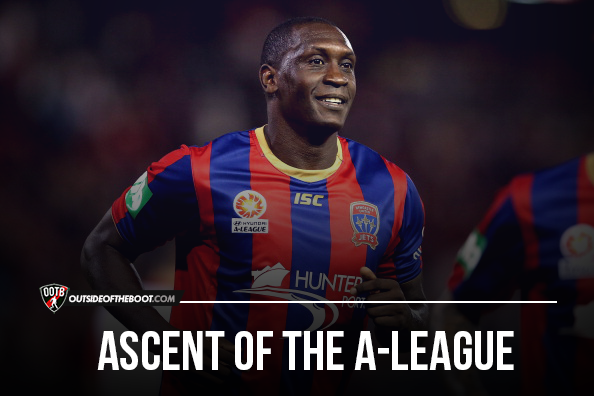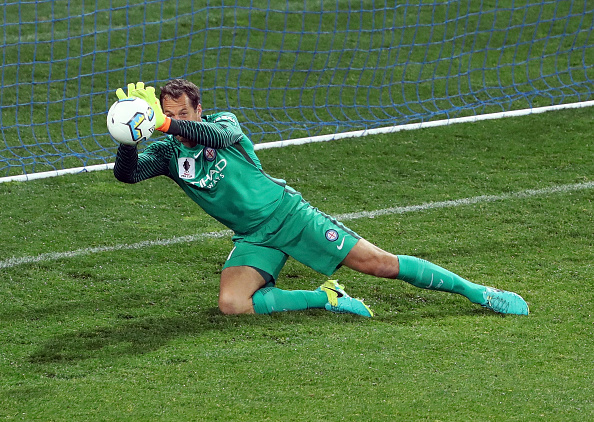Oliver McManus writres about the A-League and its journey to its current state.
Founded in 2004, as the successor to the National Soccer League, the A-League is Australia’s top division and their only fully professional league.
The league consists of 10 teams, 9 of which are from Australia and the other, Wellington Phoenix, is based in New Zealand.

Football in these two countries has often been something of a second or third choice sport; behind Rugby Union and Aussie Rules. As a result, it is fair to say, the game has often been neglected by the public – the A League was set up to counteract this ever increasing lack of interest.
So, just how successful has it been?
A very good question, so without letting the do being any furthered, let’s take a look;
It’s predecessor, as mentioned before, the NSL was established in the aftermath but, aside from the 3 main clubs of Sydney Olympic, Perth Glory and Adelaide United, the league was a distinctly dying competition.
The nail in the coffin was a damning report, in 2003, entitled the Crawford Report which declared the League “no longer financially viable”. The writing was on the wall then and the future looked rather bleak for the state of domestic football.
Out of the ashes, however, the A League was established, with the first competition taking place in October of 2005.
20 applications were received by the Football Federation of Australia (FFA), for what was to be an, initial, 8 team league.
The founding teams were announced as Adelaide United, Central Coast Mariners, Melbourne Victory, Newcastle Jets, New Zealand Knights, Perth Glory, Queensland Roar and Sydney FC. In addition to that, the title sponsor was announced as, motor company, Hyundai.
The league proved unique from the off, with its, peculiar, policy of “one city, one team” for the first 5 years. This was designed to increase local support and the quality of the game. You’re probably scratching your head as to why this particular policy is quite loved but, it’s quite simple, with this ruling in place, there could be no real spice to the rivalries and, let’s face it, we all love some spice!
The inaugural season was, well, topsy-turvy to say the least; some genuinely positive signs were shown with 41,689 fans watching Sydney jostle with the Mariners in the first ever Grand Final. On the other hand, though, games were also played in front of a measly 1000 people.
Whilst attendances can be useful in providing a snapshot of immediate popularity, it doesn’t tell you about the quality of the matches. So, take it from me, the quality in this, the first season was beyond bad.
A mixed start, granted, but there are always teething problems in any new project.
The second season was buoyed by the relative success of the Socceroos in the 2006 FIFA World Cup and, to top it off, saw the competition sign an improved broadcast deal: in a combined deal with the AFC Champions League and national matches, the league secured a 7-year, AU$120 million, contract with the flagship premium channel FOX Sports.
Match attendances increased by about 15% and, although the standard was still sub-par, there was no doubt that this fresh faced baby of a league had potential, serious potential.
A key feature in attempting to drive forward success on, both, a domestic and international level was to limit the number of foreign players to just 5 per squad, as well as a minimum of 3 under-20’s.
Not exactly ground-breaking innovation, but still, solid thinking from those in charge.
A setback was suffered in the post-season, however, as the Knights succumbed to crippling financial trouble and were replaced by the Wellington Phoenix (and who doesn’t love anything with the word Phoenix in it).
It must be said, the A League sort of entered a period of stagnated growth, with nothing really too remarkable happening for the next 3-4 years. As a result of this, we find ourselves progressing to 2010, Gold Coast and North Queensland have been granted licenses but, the next two years would prove to be dark, dark days for Australia’s premier tournament.
We’ll start with the good and the introduction of marquee players, Robbie Fowler, Alessandro del Piero and Shinji Ono all made way to Australia to ply their trade in an ever burgeoning league with increasingly passionate fans.

SYDNEY, AUSTRALIA – AUGUST 10: Alessandro Del Piero shakes hands with Andrea Pirlo of Juventus after being substituted in the second half during the match between the A-League All Stars and Juventus at ANZ Stadium on August 10, 2014 in Sydney, Australia. (Photo by Mark Metcalfe/Getty Images)
For the first time, international audiences stood up and took notice of, what was becoming, a credible force in world football
There was no escaping the obvious criticism – one which the Major League Soccer would also come to face – that of the A-League being somewhat of a retirement home.
From the outside, it is hard to argue against that because, whilst wages may not be particularly high over in Oz, it was undoubtedly a tempting proposition for players past their prime.
And yet one player had an incomprehensible effect on the nation – one by the name of Emile Heskey.
Having joined Newcastle Jets in 2012, the much maligned striker set about putting the record straight – he could indeed hit a cows a** with a banjo. And he did! He hit it 10 times in 42 A-League appearances, including an ironically laboured overhead kick (somewhat of a juxtaposed sentence, but still).
Such was the man’s popularity, that TV in Australia invented Heskey Cam whereby viewers could watch Heskey’s every movement for the full 90 minutes.
Despite this sudden cult following, the league still appeared to struggle domestically, with clubs unable to make sustainable profits and the League being tied to a broadcasting contract which failed to appreciate its increased popularity; not to mention, it was only available to 7% of the country to watch.
So, more about these dark times then.
Two of the expansion clubs (North Queensland and Gold Coast), both folded within their first 2 years of operation and, in a weird act of self harm, the Socceroos’ continued success ensured that some of the best players moved to Europe in search of fame and, let’s be honest, a bit more money.
In stepped the Western Sydney Wanderers and Melbourne Heart to bolster team numbers and, well, in a myriad of world problems, order was restored in the A League, once more.
Coinciding with the new broadcast deal with SBS, which represented a 100% increase on availability and a 40% increase on financial value, the A League seemed to turn the corner into, what I like to call Sustainability Street (the proudest pun I have ever made).
Onwards and upwards then for Australian football and, in 2014, the new FFA Cup was introduced, giving semi-professional and, well, basically Sunday league teams, the chance to compete with the best in the nation.
In 2016, 704 teams entered the competition and, just to put that into perspective, 736 entered the English FA Cup. If ever there was a statement that football had made it in Australia then, this was it, a country 2 and a half times smaller than “the home of the beautiful game” is all but matching it in terms of participation numbers.
Those who watch the A League, as I occasionally do, will know that the difference in quality from, say, 4 years ago is simply off the scale.
Complete with genuine household names like Thomas Sorensen, the A League bleeds passion, and showcases all that Australia has to offer. It’s still not up there with the likes of Europe’s top leagues, but it’s far better than the money lavished Chinese Super League which says a lot really for that competition.

MELBOURNE, AUSTRALIA – SEPTEMBER 21: Melbourne City goalkeeper Thomas Sorensen makes a save during the FFA Cup Quarter Final between Melbourne City and Western Sydney at AAMI Park on September 21, 2016 in Melbourne, Australia. (Photo by Robert Cianflone/Getty Images)
The future looks bright for the A League,with plans to expand to 14-16 teams underway, with 2 teams to be added in time for the 2018/19 season. Roll on Wollongong.
I wouldn’t say this project is going to be a world beater, it strikes me as cosy but, what it has done, is lay the foundations for future success. And, for that, it can hold its head high.
- Syria: The path to World Cup qualification - July 8, 2020
- The story of South Africa’s topsy-turvy footballing journey - November 8, 2017
- Interview: Sunil Chhetri on his foreign stints, Bengaluru FC, and the rise of Indian football - October 24, 2017
























































